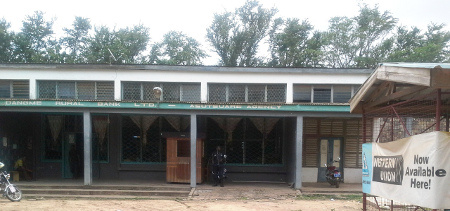-
About
- Our Work
- Get Involved
- Stay Updated
The endless possiblities of rural banking
 Fortunate delegates at the 6th Africa Agriculture Science Week in Accra, Ghana had an opportunity to visit Kpong Irrigation Scheme, one of Ghanas largest irrigation projects. Rice farming, the projects main activity is taking place on 1,870 hectares of land a providing a source of livelihood for 2,840 rice farmers. Like any other person with an income, these farmers require financial services especially savings and credit services.
Fortunate delegates at the 6th Africa Agriculture Science Week in Accra, Ghana had an opportunity to visit Kpong Irrigation Scheme, one of Ghanas largest irrigation projects. Rice farming, the projects main activity is taking place on 1,870 hectares of land a providing a source of livelihood for 2,840 rice farmers. Like any other person with an income, these farmers require financial services especially savings and credit services.Dangme Rural Bank Limited is a financial institution located at the Kpong irrigation scheme. It offersmicro-credit to rice farmers within the scheme. All this may sound rather dull, but it gets better!
The bank gives cash loans to farmers for the purchase of farm inputs, and the farmers pay back the loans in you guessed it rice! Before receiving the loan, the farmer is told exactly how many bags of rice he will have to give back to the rural bank. The bank then processes and sells the rice to recover its money.
This strategy is not only innovative, but downright daring for a financial institution. Most similar institutions throughout the world would rather get back their money in cash due to the unpredictability of the market for rice at any given time. However, Dangme Rural Bank understands its customers very well and has gone out of its way to tailor its micro-credit services to their needs.
Credit for Young Farmers
I particularly like the Dangme Rural Bank model of microcredit because I think it would work very well for young farmers. Many youth who would like to be involved in value chain have a hard time raising capital. Mainstream financial institutions do not consider these young people credit-worthy because they have no collateral or, even worse, are struggling to pay off their student loans.
Wouldnt it be grand we had a financial institution that lends to organized groups of young farmers? And then allows them to pay back the amount in farm produce? I think some banks and micro-finance institutions have already gotten the first part right. However, being able to accept payment in produce is what most of them need to work on. It would solve the challenge of lack of capital for many young farmers.
Also, they could always go a step further and give loans in the form of seed and fertilizer, creating a completely cashless system. Another option is to combine micro-credit with micro-insurance to make farming less risky for young farmers just getting started. This way, even if there is crop failure, the insurance company pays back to the bank what the farmers owes. The only cost to the farmer is the insurance premium. In my opinion, the possibilities for cooperation in agricultural financial institutions are virtually endless.
Source: Original blogpost by Grace Wanene, a social media reporter for AASW6 on the FARA-AASW blog.
About the author
Related Posts
Comments
No comments made yet. Be the first to submit a commentBy accepting you will be accessing a service provided by a third-party external to https://ypard.net/
Get in touch
Email: [email protected]
YPARD Global Coordination UnitHosted by AGRIDEA and the Czech University of Life Sciences Prague
Lausanne, Switzerland and Prague, Czech Republic - Our Work

 Fortunate delegates at the 6th
Fortunate delegates at the 6th 